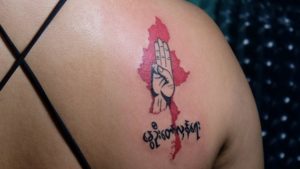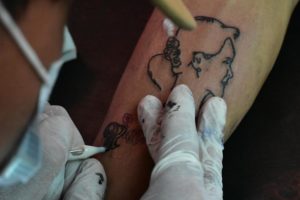
The permanent etching into one’s skin seems to be becoming an increasingly common practice in the 21st century. With the desistance of the “dangerous tattooed person” taboo within most of western culture, it seems that wherever one goes there is always a tattoo to admire for its beauty and for its message. This, however, isn’t even close to the first time that the practice of tattooing was common in a society, as instances of tattoos have remained a symbolic practice in many cultures around the world, such as the Maori people of New Zealand, and even archaeological evidence of tattoos as far back as 2000 BCE in Africa. But, with an increasing number of tattoos, comes more prevalent practices and themes, notably, symbolic resistance.

Tattoos as sign of resistance are popping up all over the world and are becoming increasingly common in societies of political polarization, extremism, and unrest. For instance, tattooed resistance has sprung up in Myanmar as the country struggles against the oppression and violence that has come since the military junta, under General Ming Aung Hlaing, seized power in the February 1st coup d’état and declared a year-long state of emergency to oppose what they have unsubstantially claimed as “massive voter fraud” in Myanmar’s recent election. Since then, incredibly large amounts of people within Myanmar have called for the return of elected leader Aung San Suu Kyi and her National League for Democracy, or NLD, party back into power. Aside from the numerous peaceful protests that have occurred all over the country, people have etched permanent signs of rebellion and calls for freedom into their skin. Artists around the country have been tattooing people with signs of freedom, such as small depictions of former leader Kyi, phrases, words, and song lyrics symbolizing freedom, and the 3-finger salute popularized from the books and movies “The Hunger Games”. These artists commonly either do it for free or by asking for donations to the Civil Disobedient Movement (CDM) in order to help fund, promote, symbolize, and encourage the push for freedom and protest. Larger depictions of Aung San Suu Kyi (as shown depicted above) and other tattoos are becoming common, popular, and depicted throughout international media as the world’s focus remains on Myanmar. Fascinatingly enough, this is not the first-time tattoos have become used as signs of protest within Myanmar, as in 1988 during the “8888 Uprising”, tattoos were also used as signs of resistance before the protests were put down with the murder of an estimated 3,000 people and ended with a similar coup.

With increasingly hostile acts by the military to suppress the protests, with conservative estimates estimating at least 600 people to have been murdered by military crackdowns, the violence is only increasing. Added to massive amounts of arrests being undertaken, even against tattoo artists for simply daring to tattoo signs of protest, it is apparent that this situation needs to be taken seriously by the international community. And as the people of Myanmar continue to push for their freedom, the act of tattooed resistance will continue to grow in practice while the international notoriety of the violent acts committed against the people of Myanmar will remain immortalized through ink.




